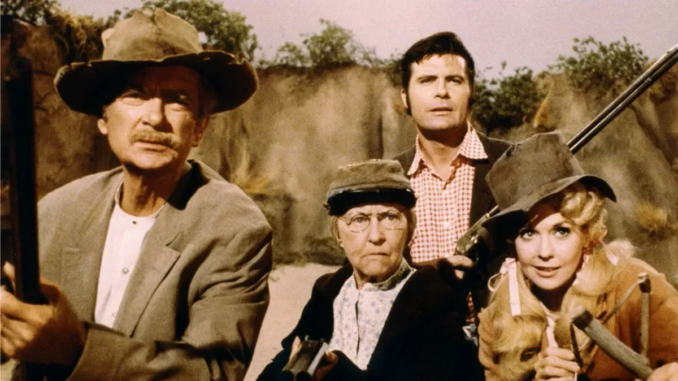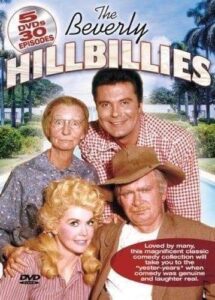
The early origins of the Beverly Hillbillies: The early life of Paul Henning
Editor’s note: Independence native Paul Henning created “The Beverly Hillbillies” and other hit TV shows. Ruth Henning tells their story in “The First Beverly Hillbilly,” published by the Mid-Continent Public Library and the Jackson County Historical Society. Those groups and others are presenting a program at 6 p.m. Friday, “Heartland to Hollywood: An Evening with the Henning Sisters.” Linda and Carol are Paul and Ruth’s daughters. The event is at Ophelia’s restaurant on the Square. Go to jchs.org for ticket information.
The following, serialized in The Examiner earlier this week, is a history of the Hennings and the Kansas City area.
By Brian Burnes
In 2013 William Chrisman High School drama students in Independence mounted a production of a show written by an obscure author with local ties.
It concerns a poor and barely-fed mountaineer family whose members remain unchanged by a sudden transformative economic windfall, despite their relocation to a new community whose comfortable residents so clearly covet their wealth.
The show was “The Beverly Hillbillies,” created by Paul Henning, a 1929 William Chrisman graduate.
Few of the students recognized “Hillbillies” when Kim Hayes, Chrisman theater advisor, announced it.
“So they just went to YouTube,” Hayes said.
The entertainment legacy of Henning, one of Jackson County’s less celebrated celebrities, remains stubbornly low profile, sometimes even in Jackson County.
That’s one reason why Ruth Henning – Paul Henning’s wife – wrote the memoir that has now been posthumously published by the Jackson County Historical Society with the Mid-Continent Public Library, “The First Beverly Hillbilly: The Untold Story of the Creator of Rural TV Comedy ,”
Paul Henning died in 2005; Ruth Henning, who finished her manuscript in 1994, died in 2002.
“Our mother always felt Daddy didn’t get the appreciation he should have,” Linda Henning, a daughter of Paul and Ruth, said recently from southern California.
“But even though my father was a self-made man, he always kind of played down what he did. My father was introverted, very quiet and shy.”
Henning, born in 1911, grew up as the youngest of an Independence family of 10 children before finding a career path at a Kansas City radio station and then following it further, leaving for Chicago in about 1937, and then again for Los Angeles in 1939 .

In the book, Ruth Henning tells how her husband became one of the most influential writers and producers in television history with the successful 1962 debut of “Hillbillies.” A second Henning program, “Petticoat Junction,” followed in 1963, with “Green Acres,” for which Henning served as executive producer, appearing in 1965.
Just as the book’s title suggests, Henning’s programs entertain millions with pastoral scenarios that were as gentle and comforting as the 1960s were raucous and disruptive.
Ruth Henning’s book touches – sometimes only briefly – on some of the several Jackson County institutions that influenced her husband’s life and career.
Among them are the Jackson County Council of the Boy Scouts of America, the Reorganized Church of Jesus Christ of Latter Day Saints (today known as the Community of Christ), Harry Truman and Kansas City radio station KMBC.
Boy Scouts
Almost every account detailing the origins of “Hillbillies” cites Paul Henning’s vivid recollections of encountering rustic Ozarks residents while attending Boy Scout camps.
The story’s emphasis seems always to be more on the exotic “hillbillies” whom Henning encountered than the scouting summer camp experience he was discovering.
Organized scouting began in the United States in 1910, one year before Paul Henning’s birth.
That August Kansas City scouting officers formed their own council at the Young Men’s Christian Association building at Tenth and Oak streets.
The concept proved immediately popular. By that October there were 1,900 Boy Scouts across the Kansas City area, with 100 more in Independence. Troop 1 in Independence was organized by the Stone Church congregation of the RLDS, and its scoutmaster W. O. Hands was considered the first scoutmaster west of the Mississippi River to be issued credentials.
Before scouting there were few organized activities for Kansas City area boys, said Andrew Dubill, author of “In the Woods: 100 Years of Boy Scout Camping in the Heart of America Council.”.
“There were a lot more ways for a city boy from Kansas City or Independence to get into trouble than healthy, fun activities organized by them for adults,” Dubill said.
In 1911 the Kansas City Department of Public Welfare, a manifestation of the Progressive Movement, counted 194 pool and billiard halls across Kansas City, with an average weekly attendance of 153,387.
Two years later the same office counted 234 churches – and 616 saloons.
